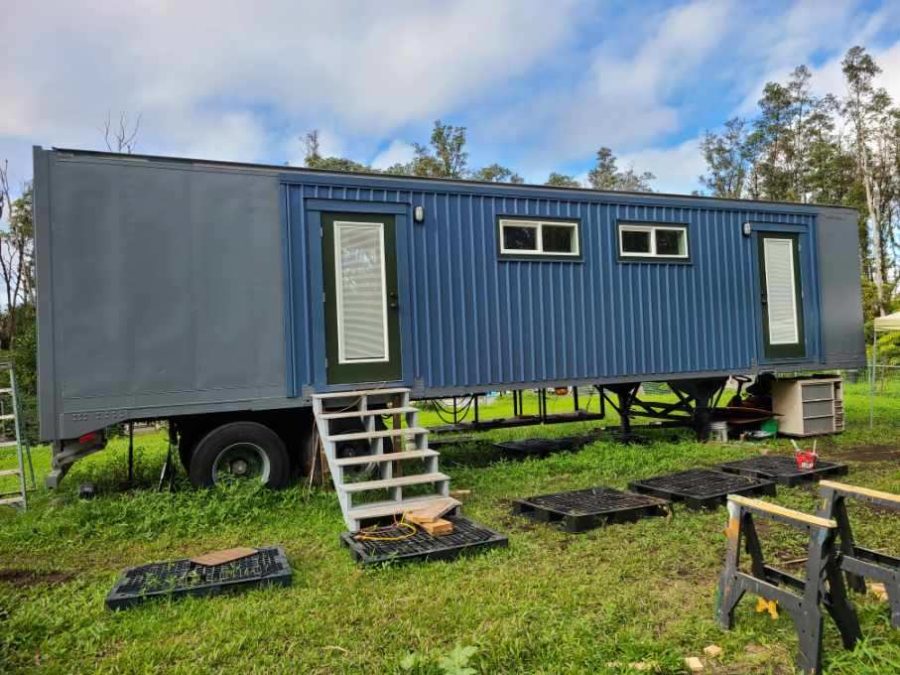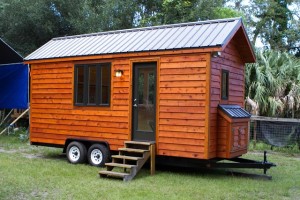This post contains affiliate links.
This is a tiny house being built on an insulated semi-trailer.
It is being built now and will be up for sale soon. It’s located in Hawaii. What do you think of it so far?
Don’t miss other interesting tiny houses like this, join our FREE Tiny House Newsletter for more!
Insulated Semi-Trailer Tiny House Build In Hawaii

Images via Belinda Hamilton
Some ventilation and extra space built out right here.

Images via Belinda Hamilton
It’s an insulated semi-trailer being recycled into a tiny house on wheels.

Images via Belinda Hamilton
You could use a semi-truck to get around. Maybe one of those self-driving Tesla Semis that are coming soon?

Images via Belinda Hamilton
Tiny house built from an insulated semitruck trailer. 40 feet long by 8 feet wide. Will be posted for sale when completely finished. Asking $100,000. Located on Hawaii Island.
Learn more
Our big thanks to Belinda Hamilton for sharing!🙏
You can share this using the e-mail and social media re-share buttons below. Thanks!
If you enjoyed this you’ll LOVE our Free Daily Tiny House Newsletter with even more!
You can also join our Small House Newsletter!
Also, try our Tiny Houses For Sale Newsletter! Thank you!
More Like This: Tiny Houses | THOWs | Tiny Houses For Sale
See The Latest: Go Back Home to See Our Latest Tiny Houses
This post contains affiliate links.
Alex
Latest posts by Alex (see all)
- Escape eBoho eZ Plus Tiny House for $39,975 - April 9, 2024
- Shannon’s Tiny Hilltop Hideaway in Cottontown, Tennessee - April 7, 2024
- Winnebago Revel Community: A Guide to Forums and Groups - March 25, 2024






The countertops are such a pretty colour!
Looks great . This is a really good way to re use a retired semi trailer. My only concern is that some of these I have looked at do not have a frame underneath , and the strength comes from the sidewalls of the trailer , ( much like a truss bridge) One would have to be super careful cutting holes in the side for doors and windows, Otherwise great job with this !
2003, in one week, we converted a 1997 Ford CF8000 commercial truck to our concept of an ExpeditionVehicle.
During that week, we sold everything with the vague goal of ‘south’ from Oregon.
Twenty-four months twenty-four thousand miles around south America.
Alaska, Panama, all over north and central America.
With nearly two decades of full-time live-aboard, we acquired a pretty good idea of value vs cost.
A long time ago…
1993, our first semi-trailer conversion was a 30′ single-axle.
We liked the compact low-profile maneuverability.
Our toter was a 1974 Chevrolet cabover with a gasoline 366ci and Allison automatic transmission.
Although we traveled the east coast of the Pacific for ten years, that combo was fine-but-less-than-ideal.
So, we refined our Requirements Statement.
And then…
2015, we acquired an all-aluminum 40′ two-axle semi-trailer.
This is a retired reefer with massive insulation.
Tragically, the insulation was soaked with moisture and odors.
After gutting the interior to bare aluminum, we re-insulated with layers:
* the first interior layer of insulation is acoustic, an adhesive-backed roll designed to minimize condensation and intrusion of exterior noise.
* the second and third layers of insulation are stand-still house rigid foam, alternating to minimize thermal bridging.
Our windows are dual-pane stand-still house 3×1 (‘3612’ in home-improvement technical talk) sliders placed high to mimic natural sunlight.
Our windows are at our eye-level while standing inside… about eight feet above the pavement to eliminate most peepers.
On our aluminum floor, we are simple:
* we laid ‘pink-board’, the insulation designed for wet areas such as a bathroom.
* above that layer is painted-sealed marine plywood, then our visible bamboo perimeter with slate inserts.
We engineered this floor system on our 1997 ExpeditionVehicle we built in 2003… and in all those years of traveling rough forest roads and Baja beaches, the pink-board shows zero-zero-zero signs of deteriorating due to our constant walking on it.
Why did we choose all-aluminum?
The front of our forty is our living quarters.
The rear is my shop with lathe, drill-press, and the usual fabrication tools to indulge my semi-hobby of a traveling aircraft mechanic.
Based on experience, a wood floor responds to flying sparks inappropriately.
If we need to move, our toter is a 2006 cabover with Cummins 8.3 and Allison 3060 automatic.
Since 2017, along with about thirty other folks in RecreationVehicles and versatile versions of ExpeditionVehicles, we workkamp at a small organic teaching farm near the outskirts of Eugene Oregon.
During ‘this phase of this Economic Lock-Down’, we think our gig is better than dealing with border crossings.
We welcome your opinions and advice on improvements!
“Based on experience, a wood floor responds to flying sparks inappropriately.” This is my favorite comment on Tiny House forums ever – I am still laughing my head off, though I suspect the story behind this comment was anything but laughable. My brother is just finishing up his first shepherd’s hut/gypsy wagon for his farm in the U.K and he is also a CAA pilot so he is going to love your story – I know he’s going to ask how he can read more of your adventure.
Amber,
2003, we converted a 1997 Ford CF8000 commercial truck to our concept of an ExpeditionVehicle.
It came with a 24′ (14,957 hectares for you foreigners) dry-van box.
I swapped that yuge box for a twelve-footer (metric equipment — 66.3 liters (aka ‘66,3’ in Euro-math)).
While welding my steel wall and door replacement for the factory roll-up door, I splattered a spark onto that old dry wood floor of the box.
To gain the experience, I allowed the spark to extinguish… except it didn’t.
I watched as an invisible force slowly created a pin-hole through so I could see the ground.
I watched as that tiny hole slowly expanded to about a thumb-width (foreign equivalent — ‘thumb-width’) across before I doused it with the garden-sprayer.
(You weld, you have a handy garden-sprayer or hose nearby.)
The flame/smolder was invisible… the hole just miraculously expanded.
It was the darnedest thing!
Wow, that was some science experiment! Assuming the repair didn’t cost too much, I think I’d have stood there and watched it too – I’m English but living in the U.S now, but the Londoner in me loves a story lol Puts me in mind of my daughter watching a NASCAR race a few years back, before I’d taught her that some flames burn invisibly. I think she was around three or four when she said, “That man is dancing around like he’s on fire!” My lifelong phobia of fire has been stoked by the thought of that spark slowly burning away in your home unnoticed – garden-sprayer or hose at the ready sounds like very good science to me!
Looking at the outside I would have never guessed how elegant it is on inside. Someone’s going to have a beautiful home.
I bought a 52′ reefer. To start I assume I need to frame out the inside before installing doors/windows. Does it matter if it’s wood or metal framing on the inside?